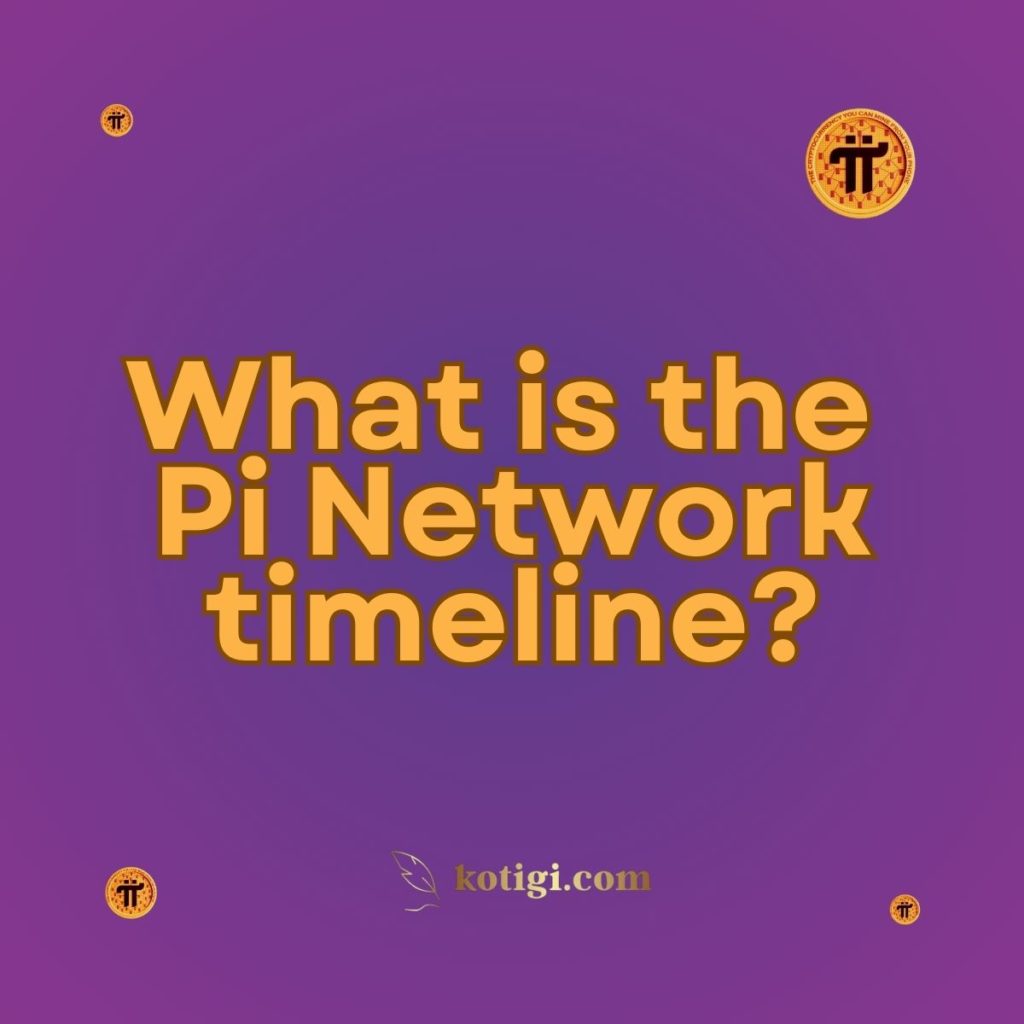
What is the Pi Network timeline?
The Pi Network timeline outlines significant milestones in the evolution of Pi, a decentralized cryptocurrency that allows mobile mining. From its launch in 2019 to the anticipated open Mainnet in 2024, this timeline captures key phases, including the Testnet, Mainnet, and future plans for full decentralization. Understanding this timeline is crucial for grasping Pi Network’s journey toward achieving mass adoption and creating a robust, user-driven ecosystem.
Introduction
Since its inception in March 2019, the Pi Network has emerged as a groundbreaking project designed to revolutionize the way cryptocurrencies are mined and accessed by everyday users. With its unique vision of making cryptocurrency mining simple and accessible, particularly through mobile devices, Pi Network presents an alternative to traditional cryptocurrencies like Bitcoin, which often require energy-intensive mining processes. The timeline of Pi Network encapsulates the evolution of this ambitious project, detailing major milestones, technological advancements, and future aspirations. This article will explore the essential phases of the Pi Network timeline, offering insights into how the network has developed and what lies ahead for this innovative cryptocurrency.
Pi Network Timeline Overview
The Pi Network timeline is structured around several key phases that showcase the project’s progression and milestones. Each phase reflects significant technical advancements, community growth, and the overall development of the Pi ecosystem. Understanding this timeline helps users and potential investors appreciate the foundational work behind the Pi Network and its ambitions to create a decentralized currency that can be mined with ease on mobile devices.
Early Development and Launch (2018-2019)
Before the official launch of Pi Network in 2019, the groundwork for the project was laid during the early development stage. In late 2018, Dr. Nicolas Kokkalis and his team at Stanford University conceptualized the Pi Network as a solution to the challenges of cryptocurrency centralization. This phase involved comprehensive research and development focused on creating a decentralized, scalable cryptocurrency that could be mined on mobile devices without high energy consumption. During this period, the Pi Network team worked diligently on developing the core technology behind Pi, particularly the implementation of the Stellar Consensus Protocol (SCP). This innovative approach aimed to facilitate an energy-efficient and accessible mining process.
Simultaneously, the team began building the mobile application, which would become the primary interface for mining Pi. The application’s user-friendly design was essential for attracting a wide range of users, making cryptocurrency accessible to those who may not have a technical background. The ease of use was a strategic decision to encourage mass participation in the network, paving the way for a growing community of Pioneers.
Official Launch (March 14, 2019)
Pi Network officially launched on March 14, 2019—affectionately known as “Pi Day” (3/14). This marked the start of the public mining phase, enabling users—referred to as Pioneers—to mine Pi coins using their mobile devices. The launch garnered immediate attention, with users attracted to the promise of easily earning cryptocurrency through a user-friendly mobile app. The initial response from the community was overwhelmingly positive, as users began to grasp the potential of mining cryptocurrency without the barriers typically associated with traditional mining methods.
During the early days of the launch, the Pi Network team focused on promoting the app, encouraging users to invite friends and family to join the network. This grassroots approach facilitated rapid community growth and engagement, essential for the network’s long-term success. The combination of innovative technology and effective marketing strategies laid the foundation for Pi Network’s ambitious goals and established a vibrant community eager to participate in the evolution of cryptocurrency.
Phase 1: The Testnet Era (2019-2021)
Following its launch, Pi Network entered the Testnet phase, a crucial period for assessing the technology and user experience in a controlled environment. This phase allowed the team to gather feedback, make improvements, and prepare for the transition to the Mainnet. The Testnet phase proved vital for refining the Pi Network’s features and capabilities.
Rapid Community Growth
A significant highlight of the Testnet phase was the explosive growth of the Pi community. By the end of 2020, Pi Network had attracted over 10 million users worldwide, showcasing robust community engagement and the potential for widespread adoption. During this phase, users could mine Pi, create security circles, and familiarize themselves with the platform’s features. This rapid expansion demonstrated the community’s enthusiasm for the project and its commitment to establishing Pi as a leading cryptocurrency.
Testing the Blockchain Infrastructure
Throughout the Testnet phase, developers rigorously tested the blockchain’s performance. This included validating transactions, optimizing user interfaces, and enhancing the overall functionality of the network. The insights gained during this phase were instrumental in refining the technology, ensuring a smooth transition to the Mainnet. Feedback from the community played a critical role in shaping the network, allowing developers to address issues and implement improvements that enhanced user experience.
Introduction of Node Operations
In late 2020, the Pi Network introduced its node program, allowing users to operate network nodes on their personal computers. This initiative marked a vital step toward decentralization, empowering Pioneers to contribute to the network’s security and transaction validation while fostering a sense of community ownership. By enabling users to run nodes, Pi Network established a foundation for a decentralized governance structure, ensuring that decision-making processes would involve community members rather than relying solely on centralized control.
Phase 2: Mainnet Launch (December 2021)
One of the most pivotal milestones in the Pi Network timeline was the transition from the Testnet to the Mainnet, which occurred in December 2021. This transition signified the establishment of the Pi blockchain as an independent entity capable of executing real transactions. The launch of the Mainnet represented a significant evolution for Pi Network, as it began operating as a fully functional blockchain network.
Transition to Mainnet
While the Mainnet remains in an enclosed stage—meaning it’s not yet connected to external exchanges—the development team emphasized that this phase is crucial for refining the network before it becomes fully operational. During this time, Pioneers could transfer their Pi balances to the Mainnet wallet upon completing the Know Your Customer (KYC) verification process. The KYC process was designed to ensure that users are verified and to prevent fraudulent activity, creating a secure environment for all participants.
Implementation of KYC Verification
Alongside the Mainnet launch, the introduction of the KYC process became essential for ensuring that only verified users could migrate their Pi balances. This verification is vital for compliance with global regulations and helps maintain the integrity and security of the network. The KYC process serves as a safeguard against fraudulent activity and promotes trust within the community. The focus on compliance has been a critical aspect of Pi Network’s development, positioning it favorably in the eyes of regulators and potential partners.
Ecosystem Development Initiatives
During the Mainnet phase, Pi Network has actively sought to expand its ecosystem by encouraging developers to create decentralized applications (dApps) and services on the Pi blockchain. Events such as the Pi Hackathon have been introduced to incentivize developers to innovate within the ecosystem, enhancing the real-world utility of the Pi cryptocurrency. These initiatives aim to create a vibrant marketplace for dApps, which will further contribute to the network’s growth and user engagement.
Phase 3: Open Mainnet and Full Decentralization (Expected 2024)
Looking forward, the next major step in the Pi Network timeline is the anticipated launch of the open Mainnet, expected in 2024. This phase is set to mark the transition to full decentralization and enable Pi to connect with external platforms and exchanges. As the network evolves, the open Mainnet is expected to be a game-changer for Pi Network, positioning it as a viable alternative in the competitive cryptocurrency landscape.
Launching the Open Mainnet
Once the open Mainnet goes live, Pi Network will fully integrate with the broader blockchain ecosystem, allowing Pi coins to be traded on external exchanges and utilized for various real-world applications. This pivotal phase is expected to set the stage for mass adoption of Pi as a functional currency. The ability to trade Pi on external exchanges will not only increase its visibility but also enhance its legitimacy as a cryptocurrency.
Transitioning to Decentralized Governance
With the launch of the open Mainnet, Pi Network aims to implement decentralized governance, transitioning toward a decentralized autonomous organization (DAO). This evolution will empower the community to play an active role in decision-making processes regarding network upgrades and changes, fostering a culture of collaboration and collective ownership. Decentralized governance is a key component of the Pi Network’s vision, ensuring that the project remains community-driven and aligned with the interests of its users.
Continued Ecosystem Expansion
During the open Mainnet phase, significant expansion of the Pi ecosystem is expected as developers roll out an increasing number of dApps and services that leverage Pi as a native currency. The Pi Network Foundation is likely to pursue partnerships with businesses and platforms that can enhance the utility of Pi, further promoting its adoption. By fostering innovation and collaboration, Pi Network aims to create a robust ecosystem that benefits users, developers, and businesses alike.
Major Milestones in Pi Network’s History
The timeline of Pi Network is punctuated by several key milestones that showcase its rapid growth and technological advancements. Here are some of the most notable moments that have shaped the project’s trajectory:
March 14, 2019 – Official Launch
On Pi Day (March 14, 2019), Pi Network officially launched, enabling users to mine Pi on their mobile devices and marking the beginning of its journey toward creating a decentralized cryptocurrency. This day is celebrated by the community as a significant turning point in the world of cryptocurrency.
Late 2020 – Introduction of Nodes
The Pi Network introduced its node program, allowing users to contribute to the blockchain’s security and decentralization by operating nodes from their computers. This was a crucial step toward enhancing the network’s reliability and user involvement.
December 2021 – Mainnet Launch
Pi Network transitioned to the Mainnet phase, marking a significant step in establishing a fully operational blockchain capable of real transactions. This milestone demonstrated the project’s readiness to enter the next phase of its evolution.
Ongoing – KYC Implementation
The rollout of the KYC process is critical for ensuring that only verified users can migrate their Pi balances to the Mainnet, promoting compliance and security within the network. This initiative reinforces the network’s commitment to maintaining a trustworthy ecosystem.
2024 (Expected) – Open Mainnet
The expected open Mainnet launch in 2024 will fully decentralize the network and enable Pi to connect with external platforms and exchanges, positioning it for widespread adoption and usability.
Conclusion
The Pi Network timeline illustrates the project’s significant milestones, from its initial launch to the current Mainnet phase and the anticipated open Mainnet. Each stage of development has brought Pi Network closer to its vision of creating a decentralized, accessible cryptocurrency that can be easily mined by anyone. As the network evolves, the coming years will be critical for determining Pi’s role in the global cryptocurrency market and its potential for mass adoption.
Key Takeaways
- Pi Network was officially launched on March 14, 2019, with the vision of creating an accessible and decentralized cryptocurrency that can be mined on mobile devices.
- Key milestones include the transition to the Mainnet in December 2021, allowing real transactions on the Pi blockchain.
- The current focus is on refining the Mainnet experience, with KYC verification and ecosystem development as essential components.
- The open Mainnet, expected in 2024, will fully decentralize the network and connect Pi to external platforms and exchanges.
- Future growth hinges on achieving mass adoption, fostering innovation, and empowering users through decentralized governance.





